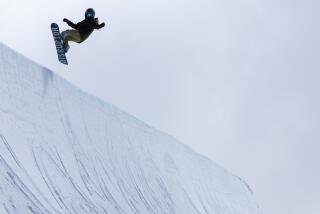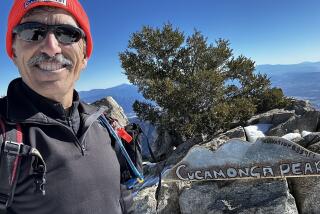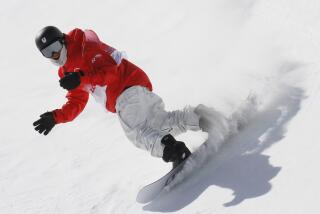Don’t Be Flaky at Snow-Sport Safety
On a typical winter Saturday, Dr. Chris Hummel and his colleagues at Mammoth Hospital in Mammoth Lakes see about two dozen patients “from the mountain,” as he calls the skiers and snowboarders injured on the nearby slopes. It’s nothing out of the ordinary for him to treat a broken leg, a dislocated shoulder, a few sprained knees, a concussion and a back problem during one of his shifts, he says.
Even so, “skiing and snowboarding are very safe if you take the right precautions,” says Hummel, director of the hospital’s emergency department. He and other experts say they notice increased safety consciousness among winter sports participants. Using common-sense precautions, including wearing the proper gear, can help you avoid injuries.
Skiing and boarding make different demands on the body, so injuries won’t be quite the same, doctors and researchers say. In skiing, the legs can go in two directions; in snowboarding, the feet are locked into the board. The quadriceps--the large muscle at the front of the thigh--does more work in skiing than in boarding, says Dr. Mark Niedfeldt, an assistant professor of family and community medicine and an orthopedic surgeon at the Medical College of Wisconsin, Milwaukee, who serves as team physician for the U.S. National Snowboarding Team. Snowboarding also requires more torso action.
When you turn on skis, you use the inside or outside edge of the foot. When you turn on a snowboard, you use the heel and toe.
Downhill skiers are most likely to suffer knee problems, such as injuries to the anterior cruciate and other ligaments surrounding the joint, says Dr. Eric Schmitter, an orthopedic surgeon at UCLA Orthopaedic Hospital Associates at Santa Monica-UCLA Medical Center. They can also suffer fractures of the upper and lower leg.
Snowboarders are more likely to suffer wrist injuries and dislocate their shoulders, Niedfeldt says. Ankle fractures are rare in skiers but not uncommon in snowboarders, he says, because most boarders wear boots that are softer than ski boots.
Some safety equipment is recommended for both sports; some is more crucial in one than the other. Helmets seem to be on the top of every doctor’s list for skiers and boarders--and they’re catching on, says Hummel of Mammoth Hospital. Hummel asks his emergency room patients whether they wear the right headgear, regardless of the injury. “It seems more and more people are wearing a helmet,” he says.
Helmets for winter sports may even be reaching the “cool” stage, Hummel says. Bicycle helmets weren’t considered hip in years past but have caught on, and the same has happened with ski and snowboard helmets, he says. “When you see snowboarders and look at the leader of the pack--and there is always a leader--it’s not unusual to see the leader wearing one,” says Hummel, who skis and snowboards.
The last holdouts? Older skiers who tell him they like to feel the wind in their hair.
Wrist guards are crucial for snowboarders. A recent study published in the American Journal of Sports Medicine compared the outcomes of more than 5,000 snowboarders in a three-month period. Half wore wrist guards, and half did not. In the group wearing wrist protection, only eight sustained wrist injuries, but there were 29 such injuries in the control group. Snowboarders who don’t use wrist guards should keep their hands in a closed fist, Niedfeldt says, to prevent falling on a hyperextended wrist.
For beginning boarders, knee pads and posterior pads aren’t a bad idea either, Niedfeldt adds. Beginning snowboarders might also consider using ski poles, a technique that some instructors teach, he says.
Besides wearing the proper safety equipment, warming up the muscles by stretching is a good idea.
Skiers who feel themselves falling should just do so, Niedfeldt says. “Most of the ACL [anterior cruciate ligament] injuries occur when the skier tries to break the fall,” he says.
The skiers most likely to get injured are beginners and those who race, says Schmitter of Santa Monica-UCLA Medical Center. Those with in-between abilities are at less risk, partly because they tend to be prudent, he says.
Beginners in either sport should take lessons, experts say. And novice skiers should select shorter skis because they are easier to maneuver.
If you’re wondering which sport to take up, Niedfeldt has some advice. “I think skiing is easier to pick up [than snowboarding]. But people can become very good boarders [more easily] than very good skiers. If you have bad knees, snowboarding is better.”
*
Healthy Traveler appears twice a month.


